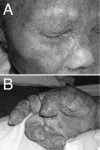Unusual laboratory findings in a case of Norwegian scabies provided a clue to diagnosis
- PMID: 15872307
- PMCID: PMC1153733
- DOI: 10.1128/JCM.43.5.2542-2544.2005
Unusual laboratory findings in a case of Norwegian scabies provided a clue to diagnosis
Abstract
The diagnosis of Norwegian scabies was missed for a year for an elderly long-term-care facility resident. Serpiginous tracks were noted on the surface of Sabouraud dextrose agar used for fungal culture of the skin scrapings. This unusual laboratory manifestation must alert clinical microbiologists to the possible diagnosis of scabies.
Figures



Similar articles
-
[Crusted scabies (Norwegian scabies) a case report].Gac Med Mex. 2006 Nov-Dec;142(6):507-10. Gac Med Mex. 2006. PMID: 17201114 Spanish.
-
Comparison of dermoscopy, skin scraping, and the adhesive tape test for the diagnosis of scabies in a resource-poor setting.Arch Dermatol. 2011 Apr;147(4):468-73. doi: 10.1001/archdermatol.2011.51. Arch Dermatol. 2011. PMID: 21482897
-
[Norwegian scabies, a rare diagnosis in Tunisia].Tunis Med. 2006 Oct;84(10):654-7. Tunis Med. 2006. PMID: 17193861 French.
-
Clinical practices. Scabies.N Engl J Med. 2006 Apr 20;354(16):1718-27. doi: 10.1056/NEJMcp052784. N Engl J Med. 2006. PMID: 16625010 Review. No abstract available.
-
What's eating you? Canine scabies.Cutis. 2003 Aug;72(2):107-9. Cutis. 2003. PMID: 12953932 Review.
Cited by
-
Clinical practice guidelines for the diagnosis and treatment of scabies in Korea: Part 1. Epidemiology, clinical manifestations, and diagnosis - a secondary publication.Ewha Med J. 2024 Oct;47(4):e73. doi: 10.12771/emj.2024.e73. Epub 2024 Oct 31. Ewha Med J. 2024. PMID: 40704002 Free PMC article.
-
Norwegian Scabies management after prolonged disease course: A case report.Int J Surg Case Rep. 2019;61:180-183. doi: 10.1016/j.ijscr.2019.07.025. Epub 2019 Jul 23. Int J Surg Case Rep. 2019. PMID: 31376739 Free PMC article.
-
Answer to April 2023 Photo Quiz.J Clin Microbiol. 2023 Apr 20;61(4):e0130322. doi: 10.1128/jcm.01303-22. Epub 2023 Apr 20. J Clin Microbiol. 2023. PMID: 37078716 Free PMC article.
-
Development of Conventional and Real-Time Quantitative PCR Assays for Diagnosis and Monitoring of Scabies.J Clin Microbiol. 2015 Jul;53(7):2095-102. doi: 10.1128/JCM.00073-15. Epub 2015 Apr 22. J Clin Microbiol. 2015. PMID: 25903566 Free PMC article.
References
-
- Brimer, L., L. Bonlokke, C. Pontoppidan, S. A. Henriksen, N. Gyrd-Hansen, and F. Rasmussen. 1995. A method for in vitro determination of the acaricidal effect of ivermectin using Sarcoptes scabiei var. suis as test organism. Vet. Parasitol. 59:249-255. - PubMed
-
- Chosidow, O. 2000. Scabies and pediculosis. Lancet 355:819-826. - PubMed
-
- Currie, B. J., P. Harumal, M. McKinnon, and S. F. Walton. 2004. First documentation of in vivo and in vitro ivermectin resistance in Sarcoptes scabiei. Clin. Infect. Dis. 39:e8-e12. - PubMed
-
- Duek, L., G. Kaufman, E. Palevsky, and I. Berdicevsky. 2001. Mites in fungal cultures. Mycoses 44:390-394. - PubMed
Publication types
MeSH terms
Substances
LinkOut - more resources
Full Text Sources
Medical

